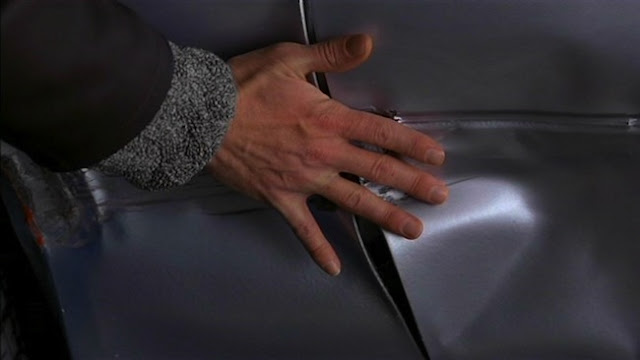Guy Maddin, man behind the curtain
AN O'HARE TRAIN RACKETS PAST as folding chairs are ferried across the rooftop behind Heaven Gallery. Both of the Milwaukee Avenue loft space’s rooms are filling up for “Like a Waking Dream,” the climax of 3 days of public appearances in Winnipeg wizard-of-film Guy Maddin’s latest Chicago roadshow. An Er-hu, a Chinese stringed instrument, is set up in the front room, and a harp and cello will be played in the other while Maddin comments on the imagery in over 600 stills he’s taken on his eccentric film sets, further exploring what he calls his “largely disused film vocabulary.”“I hope this parade of images releases the powerful nectars of remembrance in its beholders,” Maddin enthused in advance, “that every last drop of flavour in life’s juiciest and most rancid moments fall upon their tongues! It is my most sincere hope I have helped you taste yourself in the process.” It’s 40 minutes past start time. “He’s around the corner,” a woman stage whispers, extending an arm toward the blackdrop cloth at the front of the room to one side of the screen. A tall young man with a foolish hat who was just bragging on a movie he’d finished in VHS-C, says, “It’s gonna be exciting, the air is so tense it’s strangling me!” “He’s a showman.” “The suspense!” A bald man with a gray devil goatee eyes the room, spooning custard Yoplait. At the back of the room, poet Thax Douglas conspicuously shifts from foot to foot. The screen at the front of the room plays vaguely sinister clips from silent shorts. The lights shift. Douglas moves to the screen and intones, “Guy Maddin #2.” Movieside majordomo Rusty Nails, one of the organizers, rushes past, “Not yet, Thax, tell 'em a different poem first, we weren’t ready for you, buddy!” The room lapses into a dull roar once more. Finally, Thax gets the cue, and reads one of his haiku-short pileups of imagery, including the reflection that Maddin is “broadcasting from the bottom of a bowl of cereal.” The instant he finishes, a dog barks and a previously unseen, surreally enormous black standard poodle is near the front door, bridling like a bronco. As the animal’s dragged into the darkness, the screen flickers. In tight close-up, face squared off by folds of black, the overlit image intones, “I’m Guy Maddin, welcome, welcome.” The framing suggests a 19th-century photographer’s head beneath a black velvet drop. Its reflection flickers off the press-tin Fleur-de-Lys pattern of the ceiling. He invokes a few words about loving Chicago and Heaven, especially the “smoking on the rear rooftop where I understand some magical moments have transpired.” He’s his customary apologetic self about the work we’re going to see: “It makes me blush to describe myself as a stills photographer” but “it’s an honor to be the subject of a photography event in a gallery.” Maddin says that this inadvertent autobiography of “my cowardly, sleazy heart” will also show “projects that never materialized.” Once he began, he says, “I soon became an assiduous documenter.” “I bet you most of them look better through the bottom of an empty beer bottle or wine glass so why don’t you do that?” Forty minutes of stills unfold. The gentle harp and strings echo between rooms, and throughout the piece, no one speaks, a word can’t be heard, yet there is one constant strain, as if a troop of 165-pound mice were afoot. The ancient floorboards creak without cease. It’s oddly right, considering the mad material of Maddin’s early movies, as if it were the sound of a rope bridge about to snap in a sudden gale in a fictional Alpine retreat. The pictures are gamy with grain and the blast of overexposure, Maddin’s eye like a Weegee of the damaged retina and the degradation of emulsion. There are stills from The Saddest Music in the World, but also form his percussive short, Sissy Boy Slap Party and his yet-unseen feature, Brand on the Brain. Intermittently, there’s the k-shnerppp of ringtabs on cans of Old Style, and a cell-phone rackets dully as if in the pocket of a corpse beneath the floorboards. Another blue Line train bullets past. But mostly: the waterfall of footfalls. Returning, Maddin’s close-up, resembling the floating head in Zardoz, apologizes for the “squalid” spectacle. “Most of my movies are about my pre-filmmaking life but the more I try to change, the more it stays the same,” the man behind the curtain says. Thursday night at the Music Box, Maddin had stayed and talked for hours, and he worried aloud the internet and about being “too frank” on “this magnificent trip to Chicago.” “I wish I could speak to you all one-by-one but I don’t think… it’s gonna be… possible…” He turns his head to profile, looks down, and glides into the black folds of night.
[Originally published in a different form in Newcity, 23 June 2005.]
[Originally published in a different form in Newcity, 23 June 2005.]

